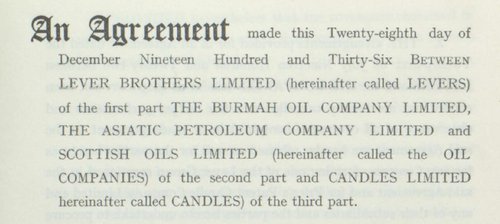Candles Ltd.

In 1923 much of Britain's candle industry was combined within a new company, called simply “Candles Ltd”. This combine included Price's Patent Candles, Britain's leading candle makers, which by then was part of the Lever Brothers conglomerate. Price's were the leading candle maker more than a decade before James Young introduced his paraffin candles, and retained the major share of the market.
From their early day's Price's included paraffin wax in the formulation of their candles, extracting this mainly from crude petroleum imported from Burma and other British interests in the far east. Candles Ltd combined Lever Bros. candle making interests with the wax trade interest of its major suppliers, the Burmah Oil Co, and the Asiatic Petroleum Company – part of Royal Dutch Shell.
Scottish Oils Ltd were both wax producers and candle makers, and competed with Candles Ltd until 1928 when agreement was signed to join the combine. Scottish Oil's Broxburn candle works then operated as part of Candles Limited, which was re-titled Prices Patent Candle Co. Ltd in about 1940.
CANDLES, LIMITED.
New Combine with Capital of £8.500,000.
A combination of the interests of Messrs. Lever Brothers and oil companies, including the Shell Company and the Asiatic Petroleum Company and their associates has been formed to develop the candle making industry on a large scale. A company under the name of “Candles, Limited" incorporates the various interests, and has a capital of £8,500,000. A high official of the Asiatic Petroleum Company stated yesteiday that the oil companies were large producers of paraffin wax, which was the principal raw material of candles. Lever Brothers control a great part of the business of candle manufacturing in this country, and the arrangement would ensure to them a steady and adequate source of supply. The Company is marketing a candle of new type. It is moulded into a triangular shape with fluted sides, and it is claimed that it gives a per cent, better illumination than the familiar round candle.
The Scotsman, 20th November 1923
- 62157 - Agreement between Lever Brothers Limited, and the Burmah Oil Company Limited, The Asiatic Petroleum Company Limited, Scottish Oils Limited and [...] - Agreement between Lever Brothers Limited, and the Burmah Oil Company Limited, The Asiatic Petroleum Company Limited, Scottish Oils Limited and Candles Limited. Dated 1936. Typed copy of the agreement between the above listed parties detailing the agreement that they will not compete in the established fields of the other companies and that if at any time such a condition should arise, the agreement states that the companies will meet and discuss the matter.

